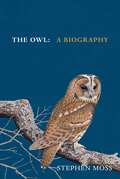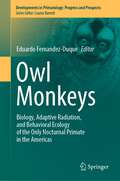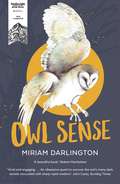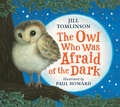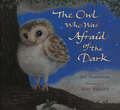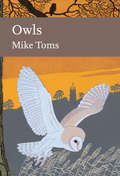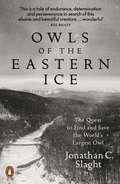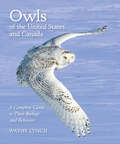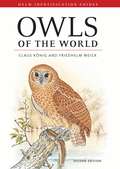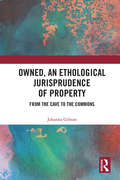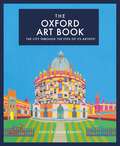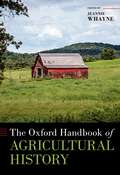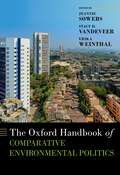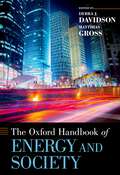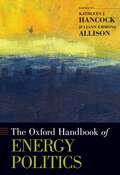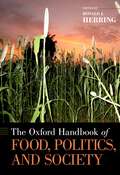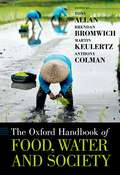- Table View
- List View
The Owl: A Biography (The Bird Biography Series #5)
by Stephen MossFrom the renowned naturalist Stephen Moss, bestselling author of The Robin, The Wren and The Swan comes a new instalment in his beloved bird biography series. Uncover the secret life of owls through this beautiful guide to these secretive and charismatic birds. Owls are among the most mysterious birds in the world. Their hauntingly beautiful calls and mostly nocturnal habits have long captured our collective imagination, inspiring more superstitions, folktales and myths than any other group of birds. Seven species of owl - the tawny, little, barn, long-eared, short-eared, snowy and eagle owl - can be found in the British Isles (out of sixteen different kinds across Europe). They have lived alongside people for thousands of years, yet we still know so little about their day-to-day lives.Discover their fascinating lives, from the moment they first hatch, to the way they hunt their prey and how they raise the next generation. Explore the rich folklore they've inspired around the world and learn how, with a bit of luck, you can catch a glimpse of them yourself.With beautiful illustrations throughout, and expert birdwatching tips, this eye-opening biography reveals the hidden secrets of one of the world's most famous and beloved birds.
Owl Monkeys: Biology, Adaptive Radiation, and Behavioral Ecology of the Only Nocturnal Primate in the Americas (Developments in Primatology: Progress and Prospects)
by Eduardo Fernandez-DuqueThis book integrates three decades of owl monkey research conducted since 1994 when the first and only book focused on the genus Aotus was published. Owl monkeys were one of the least understood primates then; knowledge from wild populations was only beginning to emerge and there had been some substantial research in colonies of captive individuals. The situation is very different today. Research on captive owl monkeys has continued to develop, with valuable contributions to the health and medical sciences. And there is now enough information on the behavior, ecology, conservation, and biogeography of the genus that merits a synthesis. The book synthesizes new field data on the biogeography, behavioral ecology, circadian biology, population biology and demography spanning their entire continental range from Panamá to Argentina. It includes theoretical perspectives drawn from evolutionary biology, biological anthropology, anatomy, morphology and physiology, genetics, endocrinology and conservation biology to examine a specic set of adaptations that have allowed owl monkeys to exploit the nocturnal niche while functioning in a pair-living sexually monogamous system with remarkable patterns of paternal care. The author, with 30 years of research experience with both captive and wild primates, has directed the longest project on any owl monkey species and has conducted extensive original research on their biology, adaptive radiation and behavioral ecology. His expertise and published record on both wild populations and laboratory colonies makes this book one of a kind; it presents information from both captive and wild primates and explores questions through the integration of both approaches. The volume offers some additional features that make it novel in its approach: (1) brings together a combination of senior researchers who during four decades have established captive owl monkeys as a system of study with a new generation of younger scientists who have, for the last 10-20 years, been spearheading their study in the wild, (2) presents the work of a remarkably diverse range of authors representing all countries where owl monkeys are present, as well as researchers from the U.S and Europe, and (3) offers “synthesis” chapters; in doing so, it will surely become a reference book for those specifically drawn to owl monkeys, as well as for those interested in the research topics that are covered.
Owl Sense
by Miriam DarlingtonA BBC Radio 4 Book of the WeekLonglisted for the Wainwright Golden Beer Book Prize 2018A Guardian Book of the Year 2018The owl has captivated the human imagination for millennia; as a predator, messenger, emblem of wisdom or portent of doom. Owl Sense tells a new story. On 'owl walks' with her teenage son, Benji, Miriam Darlington begins a quest to identify every European species of this elusive bird. From Britain she travels to Spain, France, Serbia and Finland, and to the frosted borders of the Arctic. Along the way, however, Benji succumbs to a mysterious and disabling illness, and Miriam's endeavour soon becomes entangled with the search for his cure. Bringing the strangeness and magnificence of owls to life, Owl Sense is a book about wildness in nature but also in the unpredictable course of our human lives.
The Owl Who Was Afraid of the Dark
by Jill Tomlinson‘I loved this book as a little girl and listening to my own children reading it has brought back so many wonderful memories. A comforting story to help children face their fears and grow in confidence with the help of others.’ – HRH The Duchess of Cambridge
The Owl Who Was Afraid of the Dark
by Jill Tomlinson‘I loved this book as a little girl and listening to my own children reading it has brought back so many wonderful memories. A comforting story to help children face their fears and grow in confidence with the help of others.’ – HRH The Duchess of Cambridge
Owls (Collins New Naturalist Library #125)
by Mike TomsOwls have always featured prominently in the mythology and folklore of a variety of cultures. These mysterious nocturnal creatures are thought to be symbols of wisdom, omens of death, and bringers of prophecy. In fact, owls are one of the oldest species of vertebrate animal, with fossils dating back 60 million years.
Owl’s Lesson (A Percy the Park Keeper Story)
by null Nick ButterworthA funny Percy the Park Keeper story from highly regarded, award-winning author and illustrator Nick Butterworth, creator of One Snowy Night. Percy the park keeper is always ready to lend his friends a helping hand. When he finds a young bird who can’t fly, he asks the owl to give it some lessons. The owl is an expert at flying, or so she thinks . . . Percy and his animal friends have delighted readers around the world for over thirty years!
Owls of the Eastern Ice: The Quest to Find and Save the World’s Largest Owl
by Jonathan C. Slaght'A tautly strung adventure ... this book has changed me' Helen Macdonald, author of H is for Hawk'Remarkable. If only every endangered species had a guardian angel as impassioned, courageous and pragmatic as Jonathan Slaght' Isabella Tree, author of WildingPrimorye, a remote forested region near to where Russia, China and North Korea meet in a tangle of barbed wire, is the only place where brown bears, tigers and leopards co-exist. It is also home to one of nature's rarest birds, the Blakiston's fish owl. A chance encounter with this huge, strange bird was to change wildlife researcher Jonathan Slaght's life beyond measure.This is the story of Slaght's quest to safeguard the elusive owl from extinction. During months-long journeys covering thousands of miles, he has pursued it through its forbidding territory. He has spent time with the Russians who struggle on in the harsh conditions of the taiga forest. And he has observed how Russia's logging interests and evolving fortunes present new threats to the owl's survival. Preserving its habitats will secure the forest for future generations, both animal and human - but can this battle be won? Exhilarating and clear-sighted, Owls of the Eastern Ice is an impassioned reflection on our relationship with the natural world, and on what it means to devote one's career to a single pursuit.'Excellent' The Times'Gripping' Dave Goulson, author of A Sting in the Tale'True epic' Charles Foster, author of Being a Beast
Owls of the United States and Canada: A Complete Guide to Their Biology and Behavior
by Wayne LynchThere is no group of birds more mysterious and fascinating than owls. The loudmouths of the raptor world, they peep, trill, toot, bark, growl, shriek, whistle, chittle, whoop, chuckle, boom, and buzz. Indeed, very few actually "hoot." They have become the stuff of lore and legend—from the Roman myth that an owl foot could reveal secrets to the First Nations belief that an owl feather could give a newborn better night vision. But the truth about owls is much more exciting.In this gorgeous book, celebrated natural history writer and wildlife photographer Wayne Lynch reveals the secrets of these elusive species with stunning photographs, personal anecdotes, and accessible science. The photos alone are masterpieces. Unlike most published owl photos, which are portraits of birds in captivity, the vast majority of these were taken in the wild—a product of the author-photographer's incredible knowledge and patience. Lynch complements the photos with a wealth of facts about anatomy, habitat, diet, and family life. For each of the nineteen species that inhabit Canada and the United States, he provides a range map and a brief discussion of its distribution, population size, and status. Lynch debunks myths about owls' "supernatural" powers of sight and hearing, discusses courtship rituals, and offers personal tips for finding owls in the wild. From the great horned to the tiny elf owl, this amazing volume captures the beauty and mystery of these charismatic birds of prey.
Owls of the World (Helm Identification Guides)
by Claus König Friedhelm Weick Jan-Hendrik BeckingOwls are enduringly popular birds, but due to their nocturnal habitsmost species are difficult to see well. The plumages of many speciesare cryptic and difficult to separate by plumage alone. This problem iscompounded by the different morphs that many adopt. This book fullydescribes every known species and subspecies of owl, as well aspresenting the latest evidence on owl taxonomy, based on DNA work andvocalisations. Because voice is vital in owl identification, muchemphasis is placed on it in the book and sonograms are provided formany species. A CD of owl vocalisations will accompany the book.
Owned, An Ethological Jurisprudence of Property: From the Cave to the Commons
by Johanna GibsonThis book draws upon domestication science to undertake a radical reappraisal of the jurisprudence of property and intellectual property. Bringing together animal studies and legal philosophy, it articulates a critique of dominant property models and relationships from the perspective of cognitive ethology, domestication science and animal behaviour. In doing so, a radical new picture of property emerges. Focusing on the emergence of property models through prevailing ideas of human domestication and settlement, the book challenges the anthropocentrism that informs standard approaches to ownership and to authorship. Utilising a wide range of examples from ethology and animal studies, the book thus rethinks the very nature of property as uniquely human. This highly original contribution to the fields of property and intellectual property will appeal not only to legal scholars in these areas, as well as in animal law, but also to legal theorists and others working in the social sciences with interests in posthumanism and animal studies.
Owned, An Ethological Jurisprudence of Property: From the Cave to the Commons
by Johanna GibsonThis book draws upon domestication science to undertake a radical reappraisal of the jurisprudence of property and intellectual property. Bringing together animal studies and legal philosophy, it articulates a critique of dominant property models and relationships from the perspective of cognitive ethology, domestication science and animal behaviour. In doing so, a radical new picture of property emerges. Focusing on the emergence of property models through prevailing ideas of human domestication and settlement, the book challenges the anthropocentrism that informs standard approaches to ownership and to authorship. Utilising a wide range of examples from ethology and animal studies, the book thus rethinks the very nature of property as uniquely human. This highly original contribution to the fields of property and intellectual property will appeal not only to legal scholars in these areas, as well as in animal law, but also to legal theorists and others working in the social sciences with interests in posthumanism and animal studies.
The Oxford Art Book: The city through the eyes of its artists (The city through the eyes of its artists #2)
by Cathy Read Catriona Hopton Charlie Davies Clare Barry Clare Phillips Daniel Drury David Strong Dorothy Megaw Elizabeth Moriarty Emily Hilbourne Alice Thomson Emmie Van Biervliet Eric Gaskell Fiona Miller Gerry Coles Imogen Foxell Jan Ritchie Jane Peart Jane Strother Joe Davis John. Dew Amanda Beck John Somerscales Jon Alsop Kate Hipkiss Katharine Miller Katherine Shock Kelly Stewart Louise Hall Mark Colliass Mark Kaiser Maureen Gillespie Andrew Manson Melissa Jane Sturgeon Mike Lester Norm Chung Orsi Kozel Rachel Gracey Rahima Kenner Richard Briggs Richard O'Neil Richard Stephens Robert Kann Andrew McLellan Robin Wilson Rosie Fairfax-Cholmeley Sam Osborne Sarah Bond Sarah Moncrieff Ian Scott Massie Simon East Steve Appleton Steven Chance Sue Wheeler Bee Bartlett Susan Brown Tim Kirtley Tim Stewart Valerie Petts William Bright William Roswell Jenny Seddon Emma Bennett Bee Thomas Camilla Dowse Caroline RitsonA colourful showcase of one of the most beautiful cities in the world. Inspired by Oxford's unique architecture and historic university, over 50 artists have produced a unique collection of contemporary images illustrating all aspects of the city and surrounding area.Oxford is both a thriving city and a byword for one of the world's best universities. Its ancient buildings are the wonder of the world, still used and inhabited by an energetic and passionate student community. From tightly-packed Cornmarket street catering for the shoppers of the busy city to Oxford's lush riverside walks that provide an asylum from the bustle of everyday life, to traditional St Giles's Fair and May Day that attract visitors from across Oxfordshire and beyond, this book represents them all, including:- Quirky hidden gems such as The Eagle and Child (the pub frequented by J.R.R. Tolkien and C.S. Lewis) and the many cafes of the Covered Market- Innovative representations of classic tourist sites: the Bodleian Library, the Radcliffe Camera, the Sheldonian Theatre, Christ Church College, Magdalen College and many more...- The Mini Car Plant and Cowley Road transformed into artworksThere is so much to wonder at in this lovely book. Its enthusiasm reveals a passion for both contemporary art and the lovely city of Oxford. It will renew memories and inspire visits and revisits to all its haunts.
The Oxford Handbook of Agricultural History (Oxford Handbooks)
by Jeannie WhayneAgricultural history has enjoyed a rebirth in recent years, in part because the agricultural enterprise promotes economic and cultural connections in an era that has become ever more globally focused, but also because of agriculture's potential to lead to conflicts over precious resources. History is replete with stories of armies standing or falling as a result of their supply of agriculturally produced commodities. Civilizations have likewise succumbed because of famine or crop-related pestilence, highlighting the critical nature of agriculture to both regional and global society. The importance and fragility of agricultural systems will come into much greater focus because of climate change in the twenty-first century, something farmers the world over have begun to reckon with. As its implications are manifested in droughts and floods that hamper crop production, urban people will become ever more conscious of their own reliance upon agriculture. The contemporary critical evaluation of agriculture reflects a transition from a framework that celebrated the positive aspects of the evolution of agriculture to one that also explores its negative implications, such as the emergence of intensive and extractive agriculture that has worked to the detriment of indigenous peoples and disrupted traditional political economies. The Oxford Handbook of Agricultural History reflects this rebirth and examines the wide-reaching implications of agricultural issues, bringing together the many historiographical traditions within geographic regions across the world that intersect either directly or indirectly in terms of agricultural history. Contributors to this volume include historians from around the world and specialists in European, American, African, Middle East, Russian, and Asian history. Essays touch on the green revolution, the development of the Atlantic slave plantation, the agricultural impact of the American Civil War, the rise of scientific and corporate agriculture, and modern exploitation of agricultural labor. The Oxford Handbook of Agricultural History is an essential volume for those interested in the myriad ways that agricultural systems affect our world.
The Oxford Handbook of Agricultural History (Oxford Handbooks)
Agricultural history has enjoyed a rebirth in recent years, in part because the agricultural enterprise promotes economic and cultural connections in an era that has become ever more globally focused, but also because of agriculture's potential to lead to conflicts over precious resources. History is replete with stories of armies standing or falling as a result of their supply of agriculturally produced commodities. Civilizations have likewise succumbed because of famine or crop-related pestilence, highlighting the critical nature of agriculture to both regional and global society. The importance and fragility of agricultural systems will come into much greater focus because of climate change in the twenty-first century, something farmers the world over have begun to reckon with. As its implications are manifested in droughts and floods that hamper crop production, urban people will become ever more conscious of their own reliance upon agriculture. The contemporary critical evaluation of agriculture reflects a transition from a framework that celebrated the positive aspects of the evolution of agriculture to one that also explores its negative implications, such as the emergence of intensive and extractive agriculture that has worked to the detriment of indigenous peoples and disrupted traditional political economies. The Oxford Handbook of Agricultural History reflects this rebirth and examines the wide-reaching implications of agricultural issues, bringing together the many historiographical traditions within geographic regions across the world that intersect either directly or indirectly in terms of agricultural history. Contributors to this volume include historians from around the world and specialists in European, American, African, Middle East, Russian, and Asian history. Essays touch on the green revolution, the development of the Atlantic slave plantation, the agricultural impact of the American Civil War, the rise of scientific and corporate agriculture, and modern exploitation of agricultural labor. The Oxford Handbook of Agricultural History is an essential volume for those interested in the myriad ways that agricultural systems affect our world.
The Oxford Handbook of Comparative Environmental Politics (OXFORD HANDBOOKS SERIES)
by Jeannie Sowers, Stacy D. Vandeveer and Erika WeinthalThe complexities and scope of environmental issues have not only outpaced the capacities and responsiveness of traditional political actors but also generated new innovations, constituencies, and approaches to governing environmental problems. In response, comparative environmental politics (CEP) has emerged as a vibrant and growing field of scholarly inquiry, embracing new questions and methods even as it addresses enduring questions in the broader field of comparative politics. Utilizing a range of methodological approaches, The Oxford Handbook of Comparative Environmental Politics delves into more traditional forms of CEP--the political economy of natural resources and the role of corporations and supply chains--while also showcasing new trends in CEP scholarship, particularly the comparative study of environmental injustice and intersectional inequities. Moving beyond the field's earlier work that focused on cross-national comparisons of political institutions, regulatory styles, and state-society relations, the Handbook includes approaches from political science, anthropology, sociology, geography, gender theory, law, human rights, and development studies. Moreover, the chapters highlight scholarship from a broader range of regions, and analyze the construction and diffusion of norms, rights, ethics, and ideology across the globe and through various social movements (with a focus on approaches from the Global South). Including 42 chapters, organized across 9 sections, The Oxford Handbook of Comparative Environmental Politics explores some of the most important environmental issues through the lens of comparative politics, including energy, climate change, food, health, urbanization, waste, and sustainability.
The Oxford Handbook of Comparative Environmental Politics (OXFORD HANDBOOKS SERIES)
The complexities and scope of environmental issues have not only outpaced the capacities and responsiveness of traditional political actors but also generated new innovations, constituencies, and approaches to governing environmental problems. In response, comparative environmental politics (CEP) has emerged as a vibrant and growing field of scholarly inquiry, embracing new questions and methods even as it addresses enduring questions in the broader field of comparative politics. Utilizing a range of methodological approaches, The Oxford Handbook of Comparative Environmental Politics delves into more traditional forms of CEP--the political economy of natural resources and the role of corporations and supply chains--while also showcasing new trends in CEP scholarship, particularly the comparative study of environmental injustice and intersectional inequities. Moving beyond the field's earlier work that focused on cross-national comparisons of political institutions, regulatory styles, and state-society relations, the Handbook includes approaches from political science, anthropology, sociology, geography, gender theory, law, human rights, and development studies. Moreover, the chapters highlight scholarship from a broader range of regions, and analyze the construction and diffusion of norms, rights, ethics, and ideology across the globe and through various social movements (with a focus on approaches from the Global South). Including 42 chapters, organized across 9 sections, The Oxford Handbook of Comparative Environmental Politics explores some of the most important environmental issues through the lens of comparative politics, including energy, climate change, food, health, urbanization, waste, and sustainability.
The Oxford Handbook of Energy and Society (Oxford Handbooks)
by Debra J. Davidson and Matthias GrossThe Oxford Handbook of Energy and Society presents an overview of this expanding area that has evolved dramatically over the past decade, away from one largely dominated by structural, political economic treatments on the one hand, and social-psychological studies of individual-level attitudes and behaviors on the other, toward a far more conceptually and methodologically rich and exciting field that brings in, for example, social practices, system complexity, risk theory, social studies of science, and social movements theories. This volume seeks to capture the variety of scales and methods, and range of both conceptual and empirical analyses that define the field, while drawing particular attention to indigenous peoples, poverty, political power, communities and cities. Organized into seven sections, chapters cover social theory and energy-society relations, political-economic perspectives, consumption dynamics, energy equity and energy poverty, energy and publics, energy and governance, as well as emerging trends.
The Oxford Handbook of Energy and Society (Oxford Handbooks)
The Oxford Handbook of Energy and Society presents an overview of this expanding area that has evolved dramatically over the past decade, away from one largely dominated by structural, political economic treatments on the one hand, and social-psychological studies of individual-level attitudes and behaviors on the other, toward a far more conceptually and methodologically rich and exciting field that brings in, for example, social practices, system complexity, risk theory, social studies of science, and social movements theories. This volume seeks to capture the variety of scales and methods, and range of both conceptual and empirical analyses that define the field, while drawing particular attention to indigenous peoples, poverty, political power, communities and cities. Organized into seven sections, chapters cover social theory and energy-society relations, political-economic perspectives, consumption dynamics, energy equity and energy poverty, energy and publics, energy and governance, as well as emerging trends.
The Oxford Handbook of Energy Politics (Oxford Handbooks)
by Kathleen J. Hancock Juliann Emmons AllisonThe global, regional, and local energy landscape has changed dramatically in the twenty-first century. Many factors have affected what we know about energy: a consensus among scientists on climate change and related support for renewable energy, evolving energy and resource extraction technologies, growing resource demand in the developing world, new regional and global energy governance actors, new major fossil fuel discoveries on land and underwater in states that have previously been under-resourced, rising interest in corporate social responsibility in energy companies, and the need for energy justice. The Oxford Handbook of Energy Politics synthesizes the diverse literature on these topics to provide a foundational resource for teaching and research on critical energy issues in international relations and comparative politics. Through chapters authored by both scholars and practitioners, the Handbook further develops the energy politics scholarship and community, and generates sophisticated new work that will benefit all who work on energy issues.
The Oxford Handbook of Energy Politics (Oxford Handbooks)
The global, regional, and local energy landscape has changed dramatically in the twenty-first century. Many factors have affected what we know about energy: a consensus among scientists on climate change and related support for renewable energy, evolving energy and resource extraction technologies, growing resource demand in the developing world, new regional and global energy governance actors, new major fossil fuel discoveries on land and underwater in states that have previously been under-resourced, rising interest in corporate social responsibility in energy companies, and the need for energy justice. The Oxford Handbook of Energy Politics synthesizes the diverse literature on these topics to provide a foundational resource for teaching and research on critical energy issues in international relations and comparative politics. Through chapters authored by both scholars and practitioners, the Handbook further develops the energy politics scholarship and community, and generates sophisticated new work that will benefit all who work on energy issues.
The Oxford Handbook of Food, Politics, and Society (Oxford Handbooks)
by Ronald J. HerringFood has, for most of our species history, been intensely political: who gets to eat what, how often, and through what means? The scale of polity in question has shifted over time, from very local institutions dividing up grain piles to an international community imagined in the Millennium Development Goals of the United Nations. Simultaneously, the numbers and interests of people asserting political stakes in food and agriculture have likewise shifted up and out. Global networks advocate social justice in distal agrarian systems, promotion of some farming techniques and prohibition of others, food sovereignty or efficiencies of markets and trade. Political consumerism allows the well-endowed to "vote with their dollars" for changes in food systems far from home, but depends on certification and labeling from unseen institutions. As an object of governmentality, food has never been so prominent. The thirty-five handbook chapters confront four major themes in the politics of food: property, technology, justice and knowledge. Ronald Herring's editorial introduction asks how food is political, highlighting contention around the role of market, state and information in societal decisions. The first section of the handbook then examines technology, science and knowledge in food production. What is known - and disputed - about malnutrition, poverty and food security? The second section addresses ethics, rights and distributive justice: agrarian reform, gender inequality, entitlements and subsidies, and the social vision of the alternative food movement. The third section looks to intersections of agriculture and nature: wild foods, livestock, agro-ecological approaches to sustainability, and climate change and genetic engineering. The fourth section addresses food values and culture: political consumerism, labeling and certification, the science and cultural politics of food safety, values driving regulation of genetically modified foods and potential coexistence of GMOs, and organic and conventional crops. The fifth and final section looks at frontiers of global contentions: rival transnational advocacy networks, social movements for organic farming, the who and why of international land grabbing, junctures of cosmopolitan and local food narratives, the "supermarket revolution" and the international agrifood industry in low-income countries, and politics of knowledge in agricultural futures.
The Oxford Handbook of Food, Water and Society (Oxford Handbooks)
by Tony Allan, Brendan Bromwich, Martin Keulertz, Anthony ColmanFood, water and society: what is managed by whom, and with what impacts? Our food supply chains are at risk. Water resources--sometimes scarce, often damaged, and always under-valued--are among the major reasons why food and water security rank high every year in the World Economic Forum's major global risk analysis. A stable and sustainable food system is critical to society's survival. This Handbook shows that keeping the food system stable comes at the expense of the environment, especially of water resources and those who consume and manage them. The way the food system operates reflects hard political realities. Rather than pay for the environmental costs of sustainable production, society expects food at ever lower prices. Governments reflect their electorates in this regard. Given that farm production may account for as little as 10% of the food value chain in wealthy economies, it is striking that governments have been unwilling (or unable) to put in place the essential laws and accountability that would enable famers to ensure both production and stewardship. Corporate food traders, food manufacturers, and retailers on the other hand operate in markets that make profits and pay taxes. But these corporations are not contractually bound to utilize highly nutritious, sustainably produced food commodities. The articles in this Oxford Handbook have been written by water and food system scientists and professionals, including farmers, rarely heard voices who understand the problems of food producers, food manufacturers, and regulating markets and public policy. The articles address the blind spots of society and its public policymakers, demonstrating the importance of informing society about the consequences of its food preferences and the heroic challenges it is beginning to face. The damage we are doing to our water and soil ecosystems is as important as the damage we do to the atmosphere. Impressed by the technical and organizational advances of the past two centuries, the contributors featured in this book also take note of where economic inefficiencies and cultural deadlock in a 4,000 year old system are putting our critical food supply chains at risk.
The Oxford Handbook of Food, Water and Society (Oxford Handbooks)
Food, water and society: what is managed by whom, and with what impacts? Our food supply chains are at risk. Water resources--sometimes scarce, often damaged, and always under-valued--are among the major reasons why food and water security rank high every year in the World Economic Forum's major global risk analysis. A stable and sustainable food system is critical to society's survival. This Handbook shows that keeping the food system stable comes at the expense of the environment, especially of water resources and those who consume and manage them. The way the food system operates reflects hard political realities. Rather than pay for the environmental costs of sustainable production, society expects food at ever lower prices. Governments reflect their electorates in this regard. Given that farm production may account for as little as 10% of the food value chain in wealthy economies, it is striking that governments have been unwilling (or unable) to put in place the essential laws and accountability that would enable famers to ensure both production and stewardship. Corporate food traders, food manufacturers, and retailers on the other hand operate in markets that make profits and pay taxes. But these corporations are not contractually bound to utilize highly nutritious, sustainably produced food commodities. The articles in this Oxford Handbook have been written by water and food system scientists and professionals, including farmers, rarely heard voices who understand the problems of food producers, food manufacturers, and regulating markets and public policy. The articles address the blind spots of society and its public policymakers, demonstrating the importance of informing society about the consequences of its food preferences and the heroic challenges it is beginning to face. The damage we are doing to our water and soil ecosystems is as important as the damage we do to the atmosphere. Impressed by the technical and organizational advances of the past two centuries, the contributors featured in this book also take note of where economic inefficiencies and cultural deadlock in a 4,000 year old system are putting our critical food supply chains at risk.
The Oxford Handbook Of International Climate Change Law (Oxford Handbooks In Law Ser. (PDF))
by Cinnamon P. Carlarne Kevin R. Gray Richard TarasofskyClimate change presents one of the greatest challenges of our time, and has become one of the defining issues of the twenty-first century. The radical changes which both developed and developing countries will need to make, in economic and in legal terms, to respond to climate change are unprecedented. International law, including treaty regimes, institutions, and customary international law, needs to address the myriad challenges and consequences of climate change, including variations in the weather patterns, sea level rise, and the resulting migration of peoples.
